William Angus VC
DIRECTIONS (printable)
| Take the A26 motorway from Calais to exit 6 and leave for Bethune. At the roundabout, follow the N41 for Lille. You will eventually pick up signs for Cambrin, and as you pass through that town turn left on the D166 for Cuinchy. Cross the canal bridge and immediately turn right along the canal bank. Follow the canalside road and take the left bend into Rue De Moulin. |
| Continue until you stop at a T junction with Rue Des Blois Blancs. (Your approach is the road from the left behind the car) There is a church with a distinctive triangular bell tower on your left. Turn left into the D167 Rue De Sources. The immediate right turn road is a No Entry, forming part of a triangular layout. Take the adjoining right turn into Rue De Calvaire. | 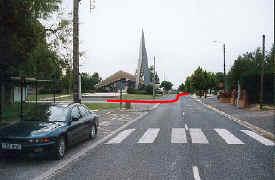 |
| Continue on Rue De Calvaire through the village until you reach the last houses. The last on the right is a comparatively modern house. On the opposite side of the road is an old house with the road ahead continuing as Rue De Calvaire. Turn left at that house into the original Rue De Calvaire (blue sign on house wall) and follow that road. | 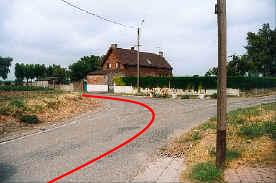 |
| The road almost immediately becomes a track. Continue along the track away from the house. The embankment now starts on your right hand side. There is a small shed on the embankment ahead. Pass the shed and you will see that the track takes a sharp bend to the right. | 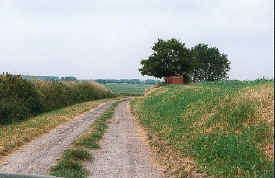 |
| Follow the track around the sharp right hand bend. Just past the two trees you will see the gap caused by the mine. Park safely beyond the gap. The mine was exploded in the embankment, and caused a long crater that extends into the embankment, having reduced it to ground level at this point. | 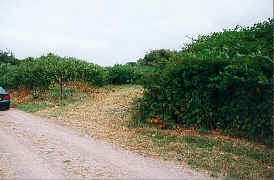 |
| Standing in the crater with your back to the gap, the British trenches lay at the division of the field immediately ahead and the one beyond it. In summer the crops have a different colour that highlights this division. The British attack on the embankment came from your 10 o'clock position, aimed at the corner point of the embankment.. | 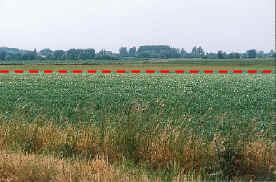 |
| The embankment from where William Angus VC rescued Lt Martin. This is the viewpoint the British troops would have had of the rescue. It is presumed that Lt Martin would have been blown onto the embankment somewhere between the gap and the point of approach at the corner of the track. |